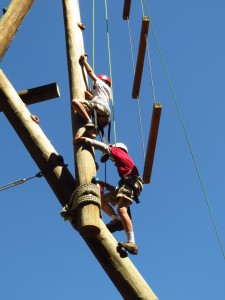Written by Shea Hillinger
Ropes Specialist
“I’m giving you the job of making up the sport Towerball.” –Sharon Ross, Ropes Supervisor
“I was scared–they were climbing so fast!” –Michal Sela, Mishlachat
“This is a great game you’ve come up with.” –David Berkman, Camp Director
The tower is my favorite part of camp. I love climbing, I love the challenges, I love the excitement in kids’ faces as they look to the top. When I was given the task of creating a sport called Towerball, I knew that it was meant for me. I immediately went to our Waterfront Director, David Kaplan, who I knew would be just as interested in creating Towerball. We got to work.
Right away, David came up with a goal for the game: get a ball up the tower while avoiding the other team. I knew I found the right partner. Together, we put together specifics. We hashed out the point system, determined the rules of play, and considered the logistics of playing on the Tower. Towerball was a thing. Less than a week later, I had my first group of players.
The group was all seventh and eighth graders, younger than I’d been planning but eager to play. I had players of all skill levels, boys and girls alike. The first day, we were rained out. The second day, we ran drills, got the kids used to carrying the ball up the tower, and had the teams spend time strategizing. I immediately figured out that the game was more difficult than I’d originally envisioned and made adjustments to rules and points as necessary. On the third day, we played.
To play Towerball, each player starts with a flag belt for their team color. Here at camp, we usually play with a Yellow team and a Red team. The offensive team starts on the first level of the tower and it is the job of the defense to catch up from the ground. If the defense can reach an offensive player while they have the ball, they can pull their flag off, ending that team’s turn. Getting to the first platform on the tower is 1 point, the second platform is worth 2, and the top of the tower (the third platform) is worth 10 points. (In the infant stages of Towerball, the platforms were worth 1, 2, and 3 points respectively. Balancing the points is definitely the aspect of the game that takes the most finesse and upon realizing the difficulty of reaching the top, I knew that the points for that platform should be game changing.)
With the hour of time allotted to chuggim and four teams to rotate through, games last 20 minutes each, with ten minutes of set-up and ten minutes to switch teams. The first day of play was exciting, but pretty uneventful. In all 40 minutes of play, zero points were scored. That didn’t get the kids down. Even after the final whistle blew, the only negativity in the air was that the game was already over. The fourth day of Towerball chug was when everything came together. One of the teams had clearly spent some time putting together a strategy and played as a unit. They scored 9 points to the other team’s 1. Seeing that was worth the wait.
This week, I’ll have older campers playing and I can’t wait to see their take on the game. Watching Towerball grow from its very beginning, a seed of a thought, to where it is today, nearly polished and with only room to grow has been phenomenal. I hope to see it played in years to come.

